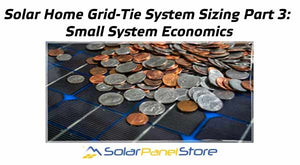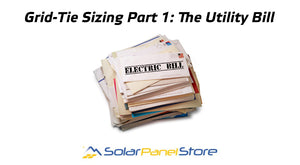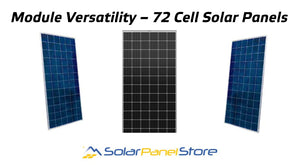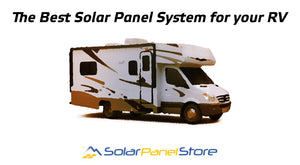Solar Panel Store Blog — Solar Panels

Solar Home Grid-Tie System Sizing Part 3: Small System Economics
In this example, I'm using the parts list detailed below, which, aside from some site specific wire runs is a fairly complete package for a roof mounted grid-tie system.
6 - Peimar 310W Black Solar Panels
1 - SMA SunnyBoy 3000W Grid Tie Inverter W/SPS
1 - 30 Ft MC4 Solar Panel Cable Extension Wire
1 - Roof Top Junction Box / Combiner Box
1 - SnapNRack Roof Mounting System (4 - 122 Inch Black Rails / 2 - Rail Splice Bars / 10 - Black Mid Clamps / 4 - End Clamps / 4 - Black Rail End Caps / 8 - Black Mounting Feet w/Flashing for Comp Shingle Roof / 8 - Lag Bolts / 1 - Rail Grounding Lug)
This package would come in at 1.86 kW (1,860 W) and cost $3,000 or less depending on some of the specific components.
It's important to make sure that under different conditions an array this small will still work well with the inverter we are using, which is obviously over-sized in comparison to the array. Many inverter manufacturers offer "String Sizing" tools on their website, I also personally like to use the MidNite Classic string sizing tool just for the data it provides to double check with the inverter specs in all different kinds of systems, it's handy as I can get the following results for this particular set-up quickly.
Array Specs:
Number of Panels In Series: 6
Number of Parallel Strings: 1
Total Modules: 6
Rated PV Array Power: 1860 Watts
Anticipated Array Power @ 104 F: 1748 Watts
Rated PV Array Current: 9.51 Amps
VMP (Maximum Power Point Voltage): 195.6 Volts
VOC (Open Circuit Voltage): 244.2 Volts
VMP @ -22 F: 238.8 Volts
VOC @ -22 F: 287.4 Volts
SunnyBoy 3.0 Inverter Specs:
Max. usable DC power: 3100 W
Max. DC voltage: 600 V
Rated MPP voltage range: 155 - 480 V
MPPT operating voltage range: 100 – 550 V
Min. DC voltage / start voltage: 100 V / 125 V
Max. operating input current per MPPT: 10 A Max.
Short circuit current per MPPT: 18 A
For small systems like this, micro-inverters like Enphase Products are also a great choice, and you really don't need to worry about any of these little details as each solar panel uses it's own inverter, so a single panel system could even be taken into consideration.
As a side note, this SPS feature could be used to charge a battery bank for emergency use using a lower cost standard battery charger and low cost inverter, because not everybody really needs the best of the best for a quick black out scenario, and these types of systems can also be fairly cost prohibitive if you're on a tight budget.
Going back to the simple payback methods described in the last blog post, I'll be using PV Watts to calculate the predicted system payback time. Here are the specs I'm using for PV Watts:
System Info:
DC System Size (kW): 1.860
Module Type: Premium
Array Type: Fixed Roof Mount
System Losses (%): 14.08 (Default Loss Calculations)
Tilt (deg): 26.57 (6:12 Roof Pitch, See last blog post for a roof pitch to degrees chart)
Azumuth (Deg): 180
Retail Electricity Rate:
Rate Type: Residential
Rate ($/kWh): 0.11
Annual Average Daily Solar Radiation: 5.72 Hours
Annual Energy Value: $330.00
If we look at the most simple payback method of the original package cost divided by the annual energy value, we come up with 9.09 years to payback. Taking the Federal Residential Renewable Energy Tax Credit of 30% into consideration, that number drops down to 6.36 years. There could and usually are state, local, and utility rebates that Solar Grid-Tie systems would qualify for as well that would drop this even further! Check out the Database of State Incentives for Renewables & Efficiency
Thanks for reading, hopefully this inspires you to check into a system for your home, the sooner it's on the roof the sooner it's going to pay for itself! Our team is always here to help from designs to sale and into the future as a new friend of the solar crew!

Solar Home Grid-Tie System Sizing Part 1: Using a Utility Bill
Step 1: Find your monthly average electricity usage from your electric bill.This will be in kilowatt-hours (kWh). Due to air conditioning, heating and other seasonal usage, it is a good idea to look at several bills. You can add the typical summer, fall, winter and spring bills and divide by four to find the average monthly usage.
Step 2: Find your daily average electricity use. Divide the monthly average number of kWh use by 30 (days).
Step 3: Find your location's average peak sun hours per day. Find what is known as an insolation map, or average sun hour list. For example, Colorado is around 5 peak sun hours. Alternatively, a PV Watts is a great online tool from NREL that will provide great insight for month by month and average solar radiation for your specific location. (https://pvwatts.nrel.gov/)
Step 4: Calculate the system size to provide 100% of your electricity. Divide your daily average electricity use by average sun hours per day. For example, if the daily average electricity usage is 30 kWh, and the site is in Colorado, system size would be: 30 kWh / 5 h = 6 kWh. It's a good idea to multiply this number by 1.15 in order to account for factors such as inverter efficiency, dirt or pollutants that may accumulate on panels, etc., if you want to cover all of your use. (One of our solar home packages in the 7 kW range would be great for this!)
Take a look at some of our system options for grid-tie packages here, or contact our sales team for more information, we are eager to help out and provide you with everything you need to go solar!
- Loren Geist
- Tags: grid tie solar Learning Solar Solar Basics Solar Panels solar size

Module Versatility – 72 Cell Solar Panels
Why choose a 72 cell solar panel?- Thomas Lindberg
- Tags: 72 cell Solar Panels

Deciding on the Best Solar Panel System for your RV
RV Solar Panels

Shopping for RV solar systems can be a drag if you don't have the right knowledge on what you will need for your situation. Solar panel mounting tends to be difficult if you've never done it before but we're here to help you along every step of the way.
Steps to deciding on the right solar system for Rv's
1) Decide what kind or RVer you are
First off, you will need to categorize your RV usage - that is, are you a full-timer? Or are you someone who just gets away for the weekends? If you fall in either of these categories, you'll want to really do the math before investing in a solar panel system. But if you're someone who tends to go away off the grid for extended periods of times but you're not a full-timer, then you should consider one of our solar electric systems. Why is this the most likely scenario where your investment will really pay off? Because the weekend warrior will always have enough battery to get through the weekend. And full-timers will most always find somewhere to doc where power is supplied at the RV park, and you're going to end up paying for that electricity anyway with your park fees. Same goes for marine solar, you need to ask yourself whether you'll have shore power or if you'll be spending extended periods on the water without a generator.
2) Decide how much solar power you will need
Electricity consumption differs from user to user. For example, if you have a larger RV with a microwave, TV, lighting, water pumps and electrical hookups for other devices, you'll need a different RV solar kit than someone who has a smaller RV that needs to run less lighting and perhaps only a water pump. So figure out how much power you'll consume in (example, 4 hours of TV might take 600 watts/hours per day, lighting = 350, refrigerator = 5,000). Then you'll need to know how much storage or battery capacity you'll need on board. From there, you'll be able to back into the numbers and get the proper setup.
An example might be needing to generate 2,000 watts per day so a nice 400 watt system would be the perfect system for someone who needed to power enough to use for that day on into the evening. Of course if you travel when you know you won't have full days of sun and some cloudy days, you'll probably want to increase the capacity for charging. It won't be too long that you'll break even after looking at a gasoline powered generator running to generate that kind of power, not to mention the impact on the environment.
3) Decide on the RV solar system or Marine system you'll need
Based on the few tips above, we'd love to help you decide on exactly what you need. Just give us a call and we'll gather your requirements and help you find the perfect, tailored solution to your portable solar panel needs.
- Dan Baldwin
- Tags: Learning Solar Solar Basics Solar Panels




